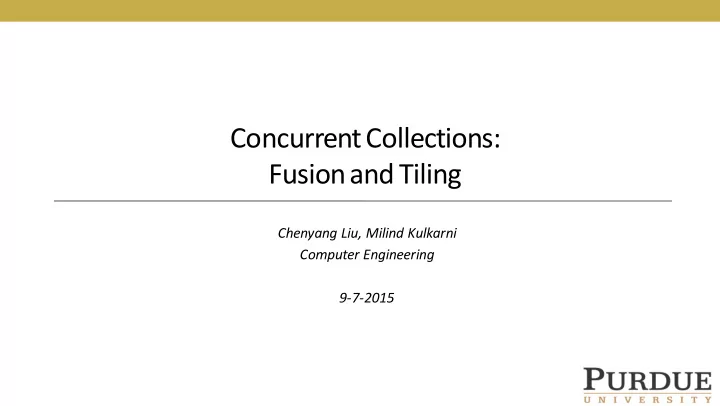

Concurrent Collections: Fusion and Tiling Chenyang Liu, Milind Kulkarni Computer Engineering 9-7-2015
2 Motivation • Previous work in recursive coupling schemes in 3D structures • Original problem is decomposed into smaller subdomains • Each subdomain is solved • Subdomains are coupled along interfaces • Lessons Learned • Partitioning matters: Subdomain sizes and interface sizes • Ordering of coupling matters: commutative and associative property • Parallelization is difficult !
3 Background • Concurrent Collections (CnC) presents a versatile framework for programming parallel applications • Separates the concerns of domain experts and performance experts • Express program algorithms as partially ordered computations • Questions: • Are there opportunities for high-level optimizations in CnC? • Graph transformations • Fusion/Fission? • Tiling?
4 CnC LULESH • LULESH: Livermore Unstructured Lagrangian Explicit Shock Hydrodynamics • Challenge problem from the DARPA UHPC program • CnC Version developed by Ellen Porter from Pacific Northwest National Laboratory (PNNL) • 3D stencil-based program • Operates on a hexahedral mesh with 2 centerings: • Node/Element interactions/computations • Complex Algorithm • Ample Parallelism
5
6
7
8 Problem • Fully decomposed algorithm results in fine-grained parallelism • Not enough work in each step! Scheduling overheads dominate. • Need to coarsen the computation • Fusion: Combine multiple steps (graph level) • Tiling: Combine multiple step instances from multiple tags • Challenge: • When is it legal to fuse or tile? • How to do it?
9 Fusion and Tiling • When can you fuse? • Step collections are prescribed by the same tag, all dependencies are within each tag space • Dependencies become serialized. Cannot fuse if a “get” depends on value “put”d from a different tag Step1: cnc.dataout.put(produced_data, my_index) Step2: For(All neighbors) {cnc.dataout.get(consumed_data, neighbor_index)} • When can you tile? • Step collection operates on multiple tags, performing the same work, independently (stencils) • Computation is serialized
10 Fusion/Tiling Step Iteration Space Step4 Step1 Step2 Step3 Step4 Step1 Step2 Step3 Tag Space Step4 Step1 Step2 Step3 Step4 Step1 Step2 Step3 Step4 Step1 Step2 Step3 Step4 Step1 Step2 Step3
11 Fusion/Tiling Step Iteration Space • Fusion Step1-Step4 Step4 Step1 Step2 Step3 Tag Space Step4 Step1 Step2 Step3 Step4 Step1 Step2 Step3 Step4 Step1 Step2 Step3 Step4 Step1 Step2 Step3
12 Fusion/Tiling Step Iteration Space • Tiling Step4 Step2 Step3 Step4 Step2 Step3 Tag Space Step4 Step2 Step3 Step1 Tile Step4 Step2 Step3 Step4 Step2 Step3 Step4 Step2 Step3
13 Fusion/Tiling: Step Iteration Space Cannot FUSE!! Step4 Step1 Step2 Step3 Step4 Step1 Step2 Step3 Tag Space Step4 Step1 Step2 Step3 Step4 Step1 Step2 Step3 Step4 Step1 Step2 Step3 Step4 Step1 Step2 Step3
14 Fused/Tiled Steps • Step collections get altered • Usually more dependencies • Larger working set, temporary data • More computation • Need to allocate data/inputs efficiently • Still need to maintain step- like behavior (‘get’s first, puts later) • Tile size tuning • Other Optimizations • Shared dependencies • Tiling may result in data reuse, especially for neighbor cases • Data Tiling: reduce total number of dependencies for tiled data structures (not tested)
15 LULESH: Fuse Algorithm
16
17 Experimental Results • AMD Opteron 6176 SE system with four 12-core processors (48 cores total) running at 2.3 GHz. • Experiments • Baseline • Fused-only • Tiled-only • Fused+Tiled Blocked (red) • Fused+Tiled Strided (blue)
18 Experimental Results cont.
19 Tiling: Block Size • Parameter: block size • Smaller size creates excess fine-grain parallelism • Larger size limits available parallelism • Sweet spot
20 Future Goals • Automatic transformations for tiling/fusion • CnC spec (graph) level data is insufficient for determining transformation legality • Data Tiling optimizations • Other scientific applications • Hierarchical CnC
21 Thanks!
22 Runtime Trace
23
Recommend
More recommend